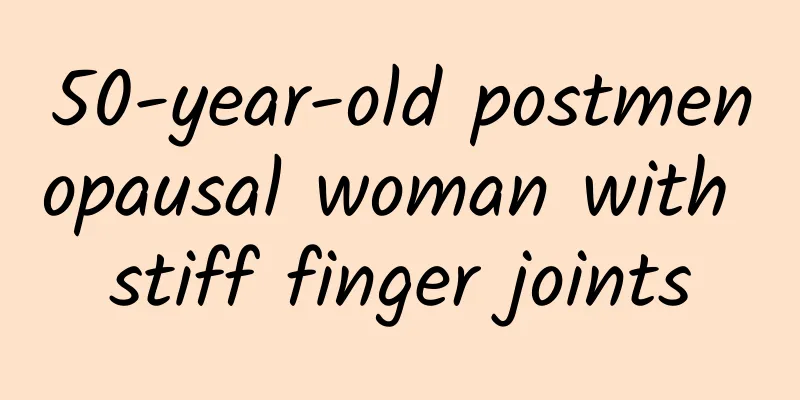50-year-old postmenopausal woman with stiff finger joints

|
Usually, 50-year-old women experience stiff finger joints after menopause, which may be caused by a variety of reasons, generally including changes in hormone levels, rheumatoid arthritis, osteoporosis, gout, cervical spondylosis, etc. The specific analysis is as follows: 1. Changes in hormone levels: After menopause, the levels of estrogen and progesterone in women's bodies drop significantly, which may cause calcium loss, leading to osteoporosis and joint stiffness. Estrogen plays an important role in maintaining bone health, and its reduction will affect bone density and bone quality, which may cause stiffness in finger joints. 2. Rheumatoid arthritis: Rheumatoid arthritis is a chronic, systemic autoimmune disease characterized by erosive, symmetrical polyarthritis. Postmenopausal women may be more susceptible to rheumatoid arthritis due to changes in the immune system, leading to symptoms such as stiffness, redness, swelling, and pain in the finger joints. 3. Osteoporosis: Osteoporosis is a systemic metabolic bone disease caused by a variety of reasons, resulting in decreased bone density and bone quality, destruction of bone microstructure, and increased bone brittleness. Postmenopausal women are more susceptible to osteoporosis due to decreased estrogen levels and accelerated bone absorption, which in turn affects the health of finger joints. 4. Gout: Gout is a joint disease caused by the deposition of monosodium urate in the body, which is related to purine metabolism disorder and reduced uric acid excretion. Postmenopausal women may have elevated uric acid levels due to metabolic changes or bad eating habits, which can lead to gouty arthritis, which manifests as stiffness, redness, swelling, heat and pain in the finger joints. 5. Cervical spondylosis: Cervical spondylosis is a clinical syndrome caused by degenerative changes in the cervical spine, which may compress local nerve tissue and affect the finger joints. With age, the cervical spine may develop degenerative changes, such as bone hyperplasia and intervertebral disc herniation, which may cause stiffness in the finger joints when compressing the nerve roots. Since these symptoms may involve multiple diseases and complex physiological mechanisms, it is recommended to seek medical attention promptly when relevant symptoms appear, conduct a comprehensive examination and diagnosis in order to identify the cause and receive targeted treatment. Maintaining a healthy lifestyle and good eating habits are also important measures to prevent and improve these symptoms. |
<<: The most obvious pain site of pelvic inflammatory disease
>>: How to best deal with ectopic pregnancy
Recommend
Clinical manifestations of patients with dysfunctional uterine bleeding
Excluding causes such as organic lesions and bloo...
The ultimate goal of anti-aging: stretching against the wall to exercise the spine without hunching or shrinking
Recently, many entrepreneurs and celebrities acci...
Will the mother's ectopic pregnancy be passed on to the child?
Patients with ectopic pregnancy are very afraid t...
What are the symptoms of acute pelvic inflammatory disease?
Acute pelvic inflammatory disease has a certain i...
Change white rice to brown rice! Speed up your metabolism and lose 700 calories in one week
Can eating help you lose weight? Many people only...
Patients with vulvar leukoplakia should pay attention to early signs
Nowadays, many men may suffer from vulvar leukopl...
When you encounter cervicitis during pregnancy, you should treat it in time
There are two types of cervicitis: acute and chro...
Analysis of the causes of pelvic inflammatory disease
I believe that everyone is familiar with pelvic i...
What medicine can reduce swelling and relieve pain in Bartholinitis?
Bartholinitis is a common disease that brings gre...
Kaka vomited again! Pregnancy rumors are flying everywhere and the goddess cries
Lady Gaga has gained 14 kilograms recently, and t...
What are the precautions after uterine fibroid surgery?
Uterine fibroids are benign tumors formed by the ...
How to treat black blood clots after abortion? What are the methods of Chinese medicine to treat black blood clots?
Many people will encounter such a situation. Beca...
There are some dietary precautions to get rid of chronic bronchitis
Chronic bronchitis refers to a chronic nonspecifi...
Reasons why cervical erosion is difficult to cure
Cervical erosion is a gynecological disease that ...
What are the hazards of Bartholinitis to women's health?
What are the hazards of Bartholin's glands to...









